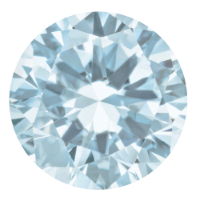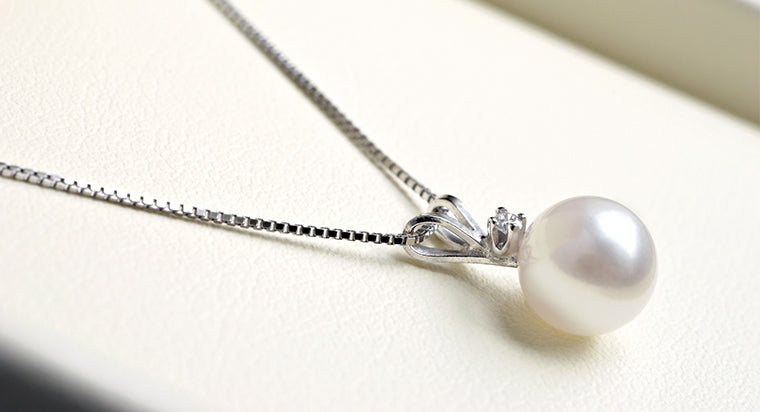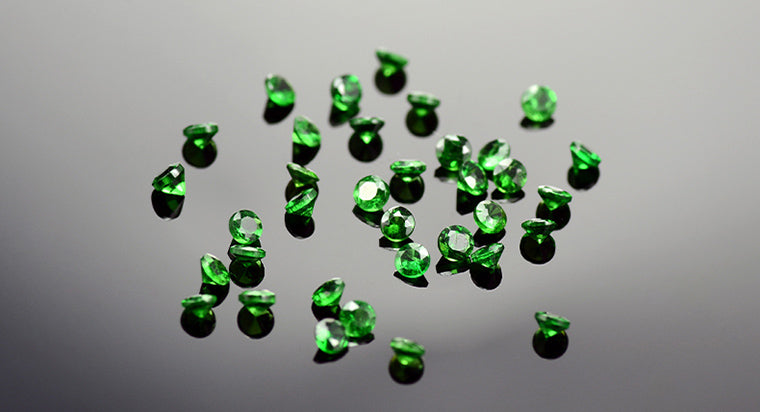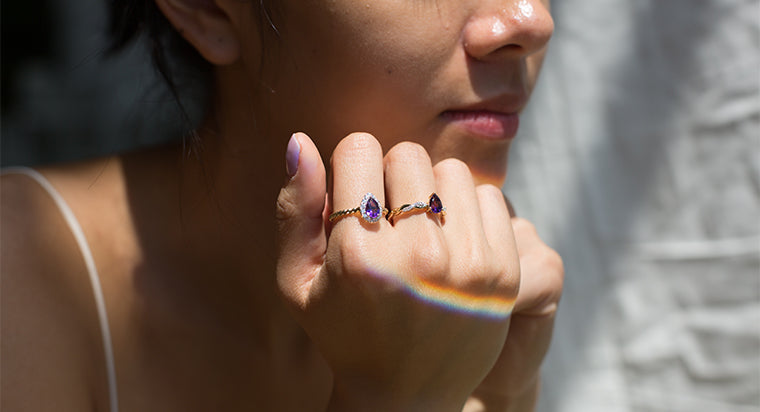Natural vs Synthetic Aquamarine
Here at With Clarity, we want to make sure that jewelry buyers are informed about the different options that are available. In recent years, buyers have been able to choose between earth-mined/natural aquamarine or synthetic aquamarine for their jewelry. So, what are the differences, and how are they important to the jewelry buyer?
TABLE OF CONTENTS
Aquamarine Basics:
Aquamarine is Made Up Of?
All aquamarine, both natural and synthetic, is a variety of beryl. This is a naturally-occurring ore of the element beryllium, more properly called beryllium aluminum silicate. When geological conditions are right, this mixture forms beautiful hexagonal crystals that are blue in color.
More About the Beryl Family: Color Variety
Beryl comes in a variety of colors, which determines the type of gem. Most famously, dark green beryl is called emerald, while morganite is pink, and aquamarine is blue to blue-green.
Round Aquamarine:

Pear Morganite:

Aquamarine Durability
Whether natural or lab created, aquamarine is a very durable gemstone. That's because beryl has a Mohs hardness of 7.5-8. This places it between quartz and corundum (sapphires and rubies) and means it's suitable for jewelry that will be worn every day. Perhaps that's one reason why more couples are choosing an aquamarine engagement ring.
Where Aquamarine Can be Found:
Regardless of the type of aquamarine (lab or natural), the blue color is derived from iron that replaces some of the aluminum in a growing crystal. Stunning mined-aquamarine crystals can be found in many parts of the world, including Russia, Brazil, Pakistan, India, and parts of Africa.
Synthetic vs Natural Aquamarine
Making Aquamarine in a Lab
Perhaps the biggest difference between natural and lab-created aquamarine is their origin. Mined aquamarines are formed deep in the earth, and are many thousands of years old. During their formation, there were all kinds of other things around the growing crystals, such as other minerals and changes in temperature.
On the other hand, in a lab, the crystals are formed in constant conditions.
- A solution is mixed that contains all the necessary chemicals, something like a recipe.
- Then, the solution is “cooked” with a consistent temperature and amounts of pressure.
Over a relatively short period of time, this solution forms into crystals that look just like natural ones. Unlike the natural ones, however, there tend to be fewer flaws in the crystal. Gemologists can tell the difference between lab-created aquamarine and natural aquamarine stone, but the untrained eye cannot.
Mining Natural Aquamarine
Unlike synthetic aquamarine, the natural variety must be mined. Famously, Brazil has a very large aquamarine deposit, and many of them are quite large. In fact, Brazil produced the world-famous Dom Pedro aquamarine (as pictured below). This designer cut obelisk is on display at the Smithsonian, and it came from a part of a 100-pound rough aquamarine stone.

Another example of Brazilian aquamarines is found in Queen Elizabeth II's jewelry collection. In honor of her coronation, the Brazilian government gave her a beautiful aquamarine necklace and earrings. She later went on to have a lovely aquamarine tiara made, and the entire set includes huge faceted stones. These are remarkable, not only for their size but also their extremely high quality.
Before being set into aquamarine jewelry, however, natural aquamarine must be mined from the earth. Often, the deposits are close to the surface and easy to access with just a shovel. Other times, the rock must be split open to access the crystals. In addition, many deposits are high in the mountains. Aquamarine is found in many of the same places as other types of beryl, including India, Pakistan, and the US.
The Main Difference: Inclusions & Price
Aquamarine Inclusions
As we said above, the main difference within a lab created aquamarine crystal and a natural one often is the number and type of inclusions. However, this gemstone is known for having a high degree of clarity in comparison to many others. This means that there tend to be few inclusions in good quality natural aquamarine, anyway. For that reason, unless you have access to gemological tools you probably can't tell the difference just by looking.
However, there is another reason why synthetics are hard to spot: heat treatment of natural stones. Although aquamarine can be found from a very pale, pure blue down to a light aqua color, heat treatment can improve the color.
In this case, the object is usually to transform a greenish stone into one with a pure blue color, which commands a higher price. Chances are that if a stone has a greenish tinge, it's a natural one. After all, the “recipe” for lab-created aquamarine will favor bluer crystals.
Aquamarine Price
Price and the reputation of your local jeweler are also good ways to know if aquamarine jewelry is made with natural or lab-created aquamarine. By law, jewelers are supposed to inform consumers which one is being offered for sale, and whether or not there are any treatments. Be sure to ask questions, and understand what you are buying.
Likewise, price is a big giveaway. Lab grown aquamarine is much less expensive than natural, at least in part because it is less rare. Production costs are much lower, as well. Remember, lab created stones imitate the highest quality natural ones, at a fraction of the cost.
You don't want to spend thousands of dollars on an aquamarine white gold ring, only to find out you have been sold something that is much less valuable. On the other hand, for someone with a low budget that wants to make a statement, lab-created jewelry is a good option.
Buying Aquamarine Jewelry
Purchasing any kind of jewelry can seem difficult. Even if you want an aquamarine birthstone ring for your sweetheart, the most important starting point is budget. At With Clarity, we have rings ranging in price from $300 to around $3,000. Styles are available with and without gemstones and/or diamonds.
Next, think about the shape. While this is a matter of taste, some shapes cost a little bit more and suit certain wearers better than others. Lastly, carat weight does affect the price. Give us a call, and we'll be happy to help you choose the right aquamarine gold ring. Contact us by phone at 1(844)-234-6463 or email at service@withclarity.com. Our Live Chat is available during business hours Monday - Friday 10AM - 6PM ET.
FAQs
What color is aquamarine?
What does an aquamarine do?
What is aquamarine good for?
Where can natural aquamarine be found?
How different does a natural vs. lab created aquamarine look?








